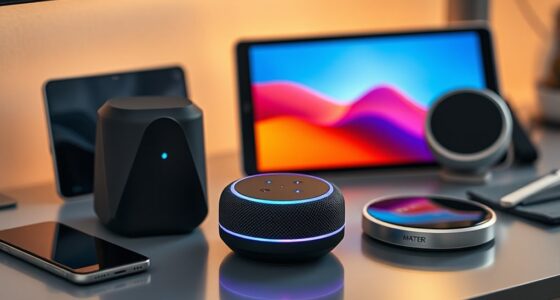Smart homes can help you save energy by automating devices and optimizing schedules, but real-world savings often fall short of expectations due to hidden costs, user habits, and environmental impacts. Devices constantly draw power, and manufacturing or disposal adds to their ecological footprint. Your behavior also influences overall efficiency. To truly understand if smart homes are worth it, you need to contemplate both their benefits and hidden costs. Explore further to see the full picture.
Key Takeaways
- Smart homes can reduce energy bills by 10-15%, but savings depend heavily on user behavior and proper setup.
- Continuous operation and data transmission in smart devices can increase overall energy consumption and hidden costs.
- Manufacturing, maintenance, and disposal of smart devices have significant environmental impacts, offsetting some energy efficiency gains.
- External factors like climate, energy prices, and regional habits influence the actual effectiveness of smart home energy management.
- Achieving true energy efficiency requires balancing technological benefits with mindful user habits and lifecycle environmental considerations.
The Promise of Smart Home Efficiency
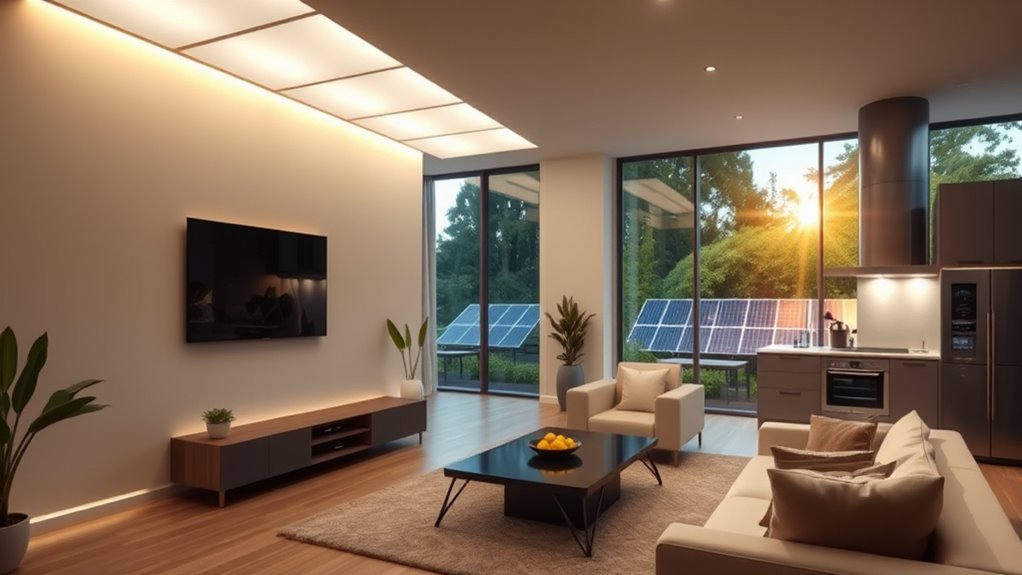
Smart home technology has the potential to revolutionize how you manage energy, making your daily routines more efficient and cost-effective. With smart home security systems, you can monitor and control access remotely, reducing unnecessary energy use from lights or appliances when you’re away. Voice assistant integration adds convenience, allowing you to control devices hands-free, adjust thermostats, or turn on security features instantly. These systems adapt to your habits, learning when to activate or deactivate devices to save energy without sacrificing comfort. By centralizing control and automating routines, smart homes help you optimize energy consumption effortlessly. This seamless integration not only enhances security but also guarantees you’re using energy wisely, leading to lower bills and a more sustainable lifestyle. Additionally, understanding industry trends can help you choose the most effective smart home solutions for maximum efficiency.
How Smart Devices Optimize Energy Use
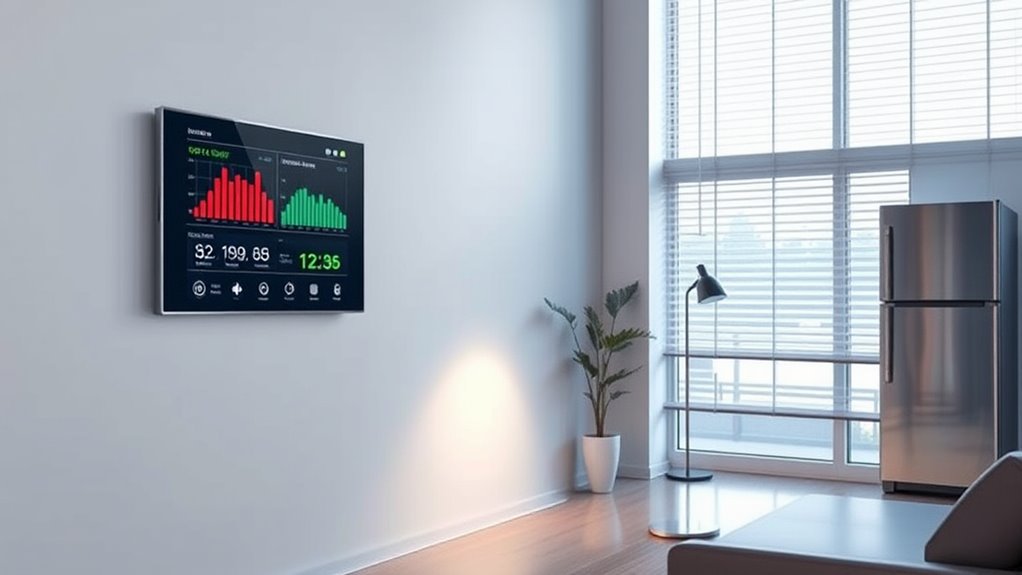
Smart devices automatically manage your energy use by adjusting settings based on your habits and preferences. With real-time monitoring, you can see how much energy your appliances consume and make informed decisions. This combination helps you save energy and reduce costs without sacrificing comfort.
Automated Energy Management
Automated energy management systems use intelligent algorithms and sensors to continuously monitor and adjust your home’s energy consumption. They analyze data from various devices to optimize usage, saving you money and reducing waste. With voice control, you can effortlessly command your system to turn off lights or adjust thermostats, enhancing convenience and efficiency. These systems also incorporate security features that safeguard your data while managing energy flows. You’ll notice smarter scheduling, adapting to your routines without manual input. Additionally, they can detect unusual patterns, alerting you to potential issues before they escalate. Overall, automated energy management makes your home more responsive, ensuring energy is used only when needed. Wheatgrass is often integrated into smart home health routines to promote wellness and energy balance, further enhancing the system’s benefits. This seamless integration boosts efficiency while maintaining comfort and security.
Real-Time Usage Monitoring
Real-time usage monitoring allows your devices to track energy consumption instantly, giving you immediate insights into how your home uses power. With access to real-time energy data, you can see which appliances or systems consume the most energy at any moment. This helps you identify inefficiencies and adjust your habits accordingly. Device metrics provide detailed information on power usage patterns, enabling smarter decision-making. For example, you might notice your HVAC system consumes significant energy during specific hours and choose to optimize its operation. By monitoring energy data continuously, your smart home can automatically adjust settings or alert you to unusual consumption. This proactive approach guarantees you’re always aware of your energy use, making your home more efficient and reducing waste. Incorporating energy-efficient devices can further optimize your home’s overall energy performance.
Real-World Energy Savings: What the Data Shows
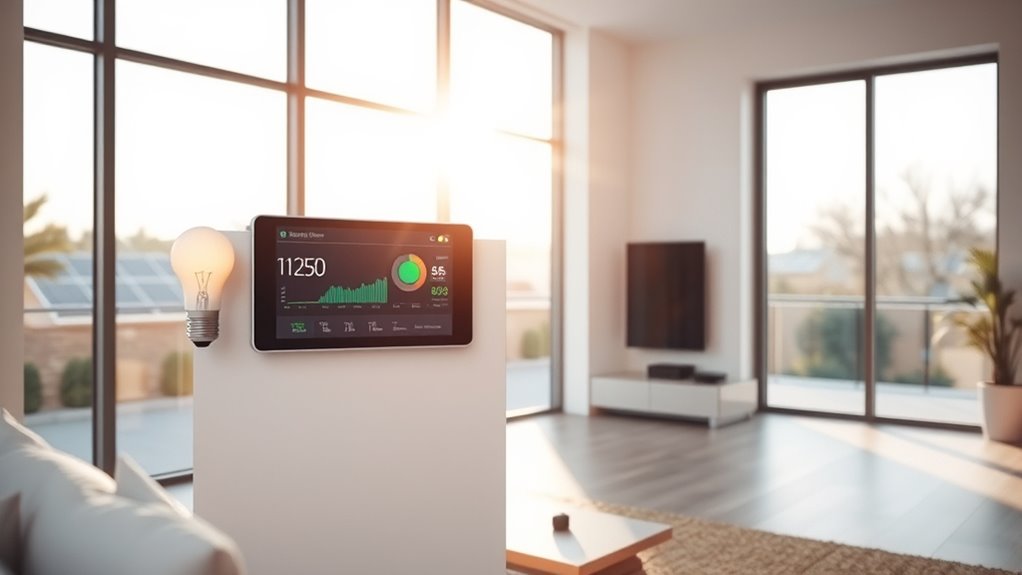
While the promise of energy savings from smart home technologies is often highlighted, actual data shows a more nuanced picture. Many homes see modest reductions, but the savings aren’t as dramatic as advertised. Factors like user habits, device efficiency, and home size influence results. Here’s what the data reveals about real-world energy savings:
Smart home energy savings are often modest, mainly influenced by user habits and device efficiency.
- Savings typically range from 10% to 15%, not the 30-50% often claimed
- Proper setup and user engagement significantly impact results
- Smart homes with integrated systems tend to perform better
- External factors like climate and energy prices also play a role
- The influence of Best Restaurants in certain regions can indirectly affect energy consumption patterns due to holiday seasons and tourism fluctuations
Hidden Energy Costs of Smart Technologies

Smart devices constantly draw power, even when you’re not actively using them, which adds to your energy bills. Data transmission between devices consumes energy that often goes unnoticed. Additionally, hidden maintenance costs for updates and repairs can offset some of your savings. Moreover, the continuous operation of smart appliances can lead to increased energy consumption, further impacting your monthly expenses.
Continuous Device Power Use
Many smart devices consume power even when they’re not actively being used, leading to hidden energy costs that can add up over time. This is due to standby power and continuous operation, which keep devices ready for quick access or updates. These devices often run in the background, increasing energy waste without your awareness.
- Devices stay on standby, drawing power 24/7
- Continuous operation means constant energy drain
- Small power draws multiply across multiple devices
- Hidden costs can considerably impact your energy bill
While smart tech enhances convenience, it can also quietly consume energy around the clock. Recognizing this helps you manage your devices better and reduce unnecessary power use.
Data Transmission Energy
Have you considered how much energy your smart devices use to transmit data? Every time your devices communicate, they rely on wireless protocols like Wi-Fi, Zigbee, or Z-Wave, which consume energy even when idle. Data transmission requires continuous signals, and frequent updates add to this energy use. Additionally, data encryption ensures your information stays secure, but it also demands extra processing power, increasing energy consumption. While these transmissions might seem minimal individually, collectively they add up, especially in a fully connected smart home. This hidden energy cost often goes unnoticed, yet it can offset some of the energy savings gained from automation. Furthermore, Kia Tuning upgrades such as ECU remapping and performance modifications demonstrate how electronic systems in modern vehicles also consume energy, highlighting the importance of considering all electronic devices’ energy demands. Understanding these transmission demands helps you better evaluate whether your smart home’s overall energy efficiency is truly beneficial.
Hidden Maintenance Costs
While the energy used for data transmission in your smart devices might seem manageable, maintaining these devices over time requires ongoing energy investments that often go unnoticed. These hidden costs include frequent upgrades that demand energy-intensive manufacturing processes and replacements. Costly repairs can also arise when devices malfunction or become outdated, further increasing energy use. Additionally, powering backup systems or extended support infrastructure adds to the hidden energy footprint. For example, some smart home components like performance kits or advanced sensors demand additional energy during their lifecycle, contributing to the overall hidden costs.
- Frequent upgrades lead to increased manufacturing and disposal energy costs
- Costly repairs consume extra energy during troubleshooting and replacement
- Legacy devices often require additional energy to integrate or maintain
- Backup systems and extended support add to ongoing energy consumption
These hidden maintenance costs challenge the overall energy efficiency of smart homes, making you reconsider their true sustainability.
The Environmental Impact of Manufacturing and Disposal
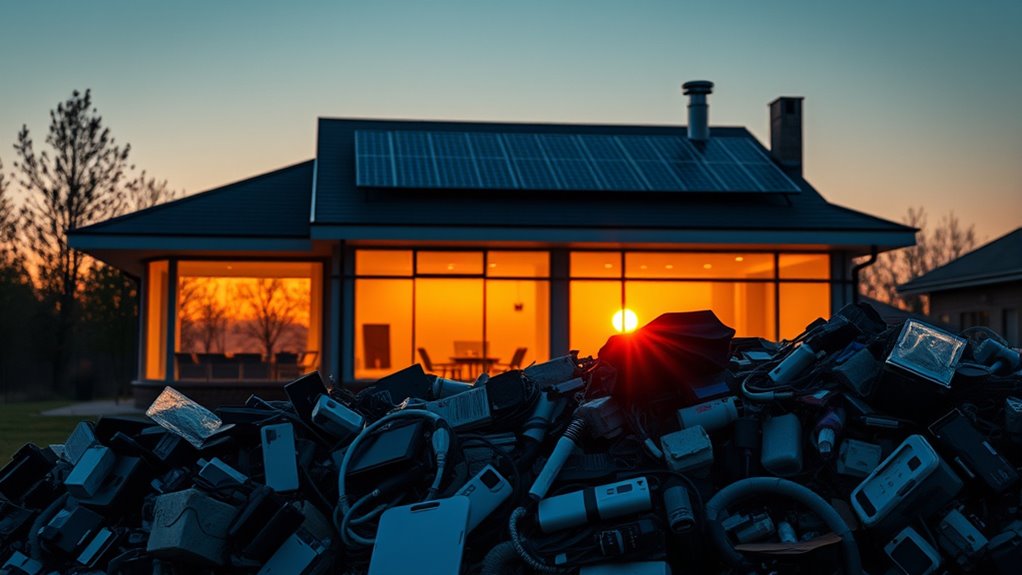
Manufacturing smart home devices often requires significant energy and resource consumption, which can contribute to environmental degradation. Their manufacturing footprint involves extracting raw materials, such as rare earth elements and metals, often through energy-intensive processes that emit greenhouse gases. Additionally, the disposal impact of these devices raises concerns; many contain non-biodegradable components and hazardous substances that can leach into soil and water if not properly recycled. The production and disposal cycle adds to landfill waste and pollution, offsetting some of the energy savings gained during use. Moreover, the environmental impacts of e-waste from discarded devices continue to pose serious ecological challenges. While smart devices aim to reduce energy consumption, their environmental toll from manufacturing and disposal reminds you that sustainability isn’t just about efficiency at home but also about minimizing the broader ecological footprint.
User Behavior and Its Effect on Energy Consumption
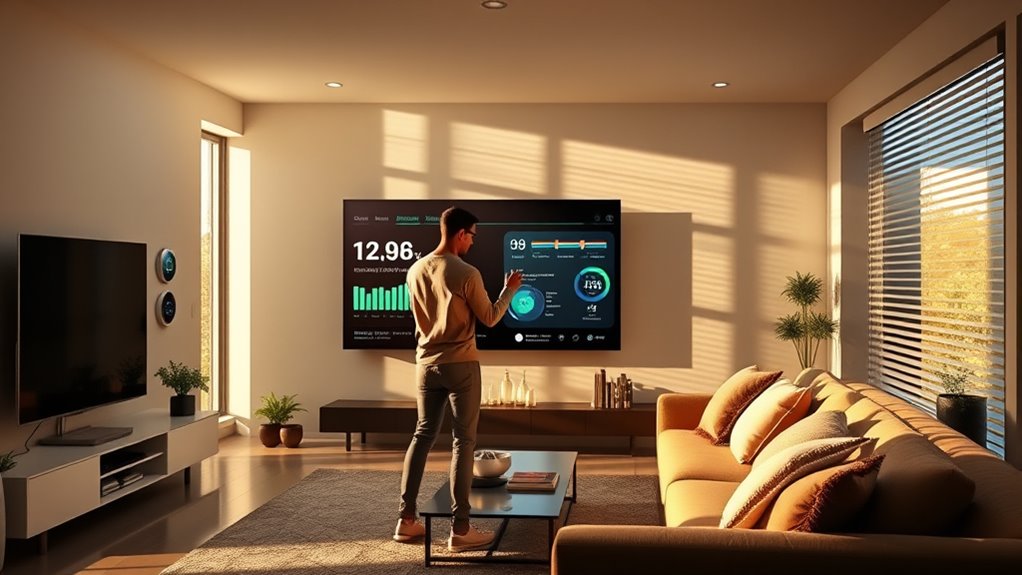
Your habits and choices considerably influence how much energy your smart home consumes. Even with advanced automation, your user habits determine actual savings. Social influence also plays a role, as family or housemates can impact energy use. Small behaviors can add up over time, reducing efficiency gains. To optimize energy consumption, consider:
- Turning off devices when not in use
- Setting smart thermostats to eco-friendly temperatures
- Encouraging others in your household to adopt energy-saving habits
- Using automation to limit unnecessary energy use during inactive periods
- Being aware of user interaction patterns that can either enhance or diminish the benefits of your smart system
Your conscious decisions and social environment shape your home’s energy footprint. The effectiveness of smart technology depends on how you and those around you interact with it. Ultimately, user behavior is vital in realizing true energy efficiency.
Are the Benefits Worth the Investment?
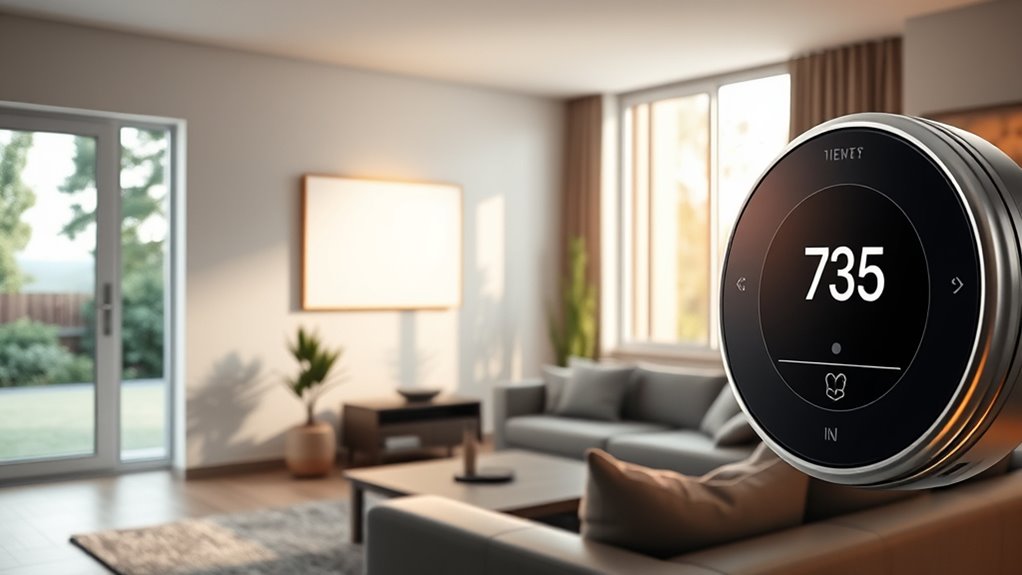
Deciding whether smart home energy systems are worth the investment depends on how much value you place on long-term savings and convenience. A thorough cost benefit analysis can help you determine if the upfront costs are justified by energy savings and increased user satisfaction. While initial expenses may seem high, many find that reduced utility bills and enhanced comfort offset the investment over time. Consider this comparison:
| Factor | Benefit |
|---|---|
| Lower energy bills | Long-term savings |
| User satisfaction | Improved comfort and control |
| Installation costs | Upfront investment |
| Maintenance needs | Ongoing expenses |
If you prioritize convenience and energy efficiency, the benefits often outweigh the costs, making the investment worthwhile. Understanding the cost benefit analysis of smart home systems can further clarify their long-term value.
Frequently Asked Questions
How Do Smart Homes Compare to Traditional Homes in Overall Energy Consumption?
You’ll find that smart homes generally have better energy consumption patterns than traditional homes. They optimize appliance efficiency through automation, allowing you to reduce unnecessary energy use. Smart systems can adjust heating, cooling, and lighting based on your habits, saving energy and costs. However, initial device setup and technology use can sometimes offset these savings. Overall, smart homes tend to be more energy-efficient, but their effectiveness depends on proper management and usage.
Can Smart Devices Malfunction and Increase Energy Use Unexpectedly?
Imagine a trusted guard dog suddenly barking at shadows—that’s like a smart device malfunction. When device malfunctions happen, they can trigger energy spikes, unexpectedly increasing your home’s energy use. These glitches might cause devices to stay on longer or operate inefficiently, leading to higher bills. So, yes, smart devices can malfunction and unexpectedly boost energy consumption, just like a guard dog barking at the wrong things.
What Are the Long-Term Maintenance Costs of Smart Home Systems?
You might notice that long-term maintenance costs for smart home systems include regular hardware upgrades and software updates. Over time, hardware can become outdated, requiring replacements, and software updates ensure security and functionality but may demand additional expenses. By staying proactive with these updates, you can minimize costs and keep your system running smoothly, ultimately helping you save money and maximize your smart home’s efficiency.
Do Smart Home Energy Savings Justify Their Initial Investment?
You might find that smart homes can cut energy bills by up to 30%, making the initial investment worthwhile. When you use smart security and voice assistants, you gain better control over your energy use, leading to savings over time. While upfront costs can seem high, the long-term benefits—less energy waste and increased convenience—often justify the investment, especially if you prioritize efficiency and modern convenience in your home.
How Do Smart Homes Impact Household Carbon Footprints Over Time?
You can considerably impact your household’s carbon footprint over time by embracing behavioral change through smart home technology. These systems optimize energy use, reducing waste, and support grid integration, which lowers overall emissions. By adjusting your habits and utilizing smart devices, you contribute to a cleaner environment, cutting your carbon footprint. Over time, this proactive approach makes your smart home a powerful tool for sustainable living.
Conclusion
While smart homes offer tempting promises of energy savings, the true story is a bit more nuanced. Behind the sleek devices lie hidden costs and habits that can sway the balance. If you’re willing to navigate these complexities, you might find that smart technology can be a subtle ally in reducing your footprint. Ultimately, weighing the benefits against the hidden factors will help you decide if this promising path is right for you.


